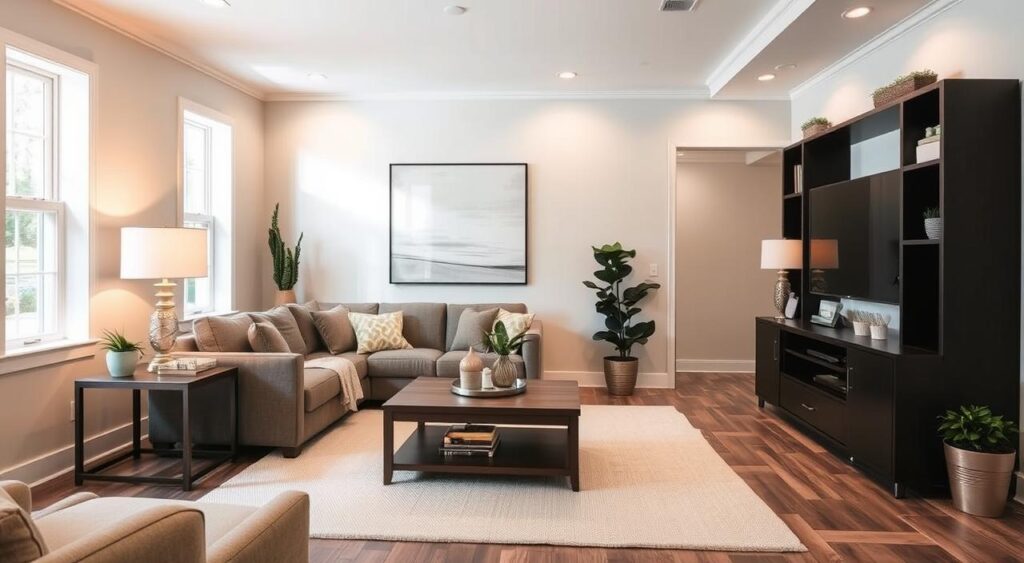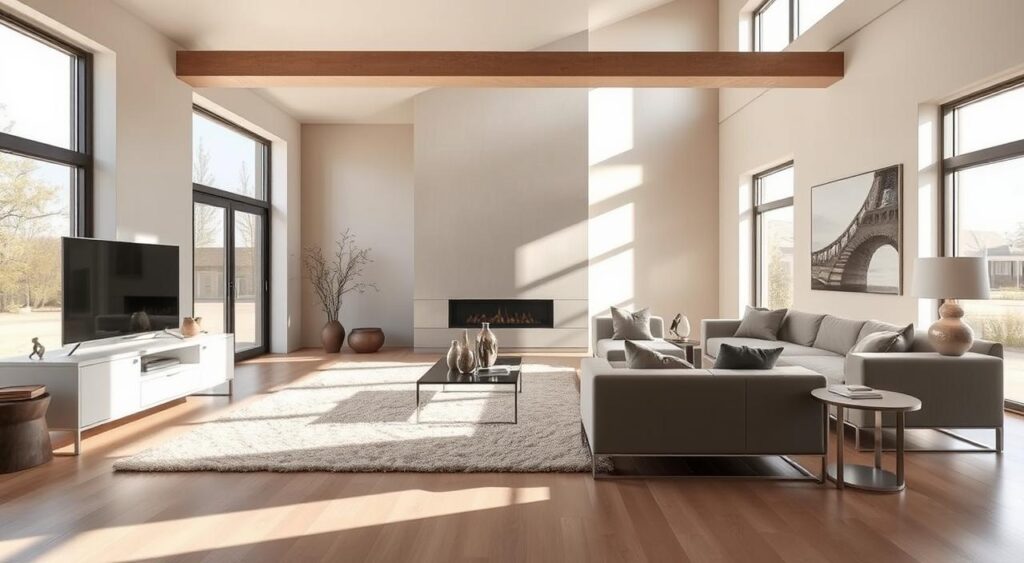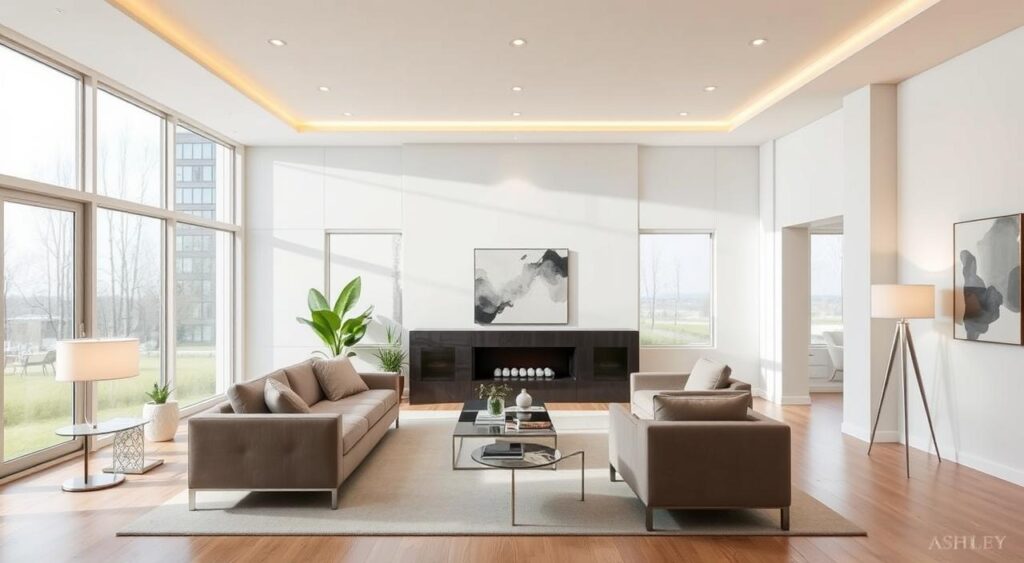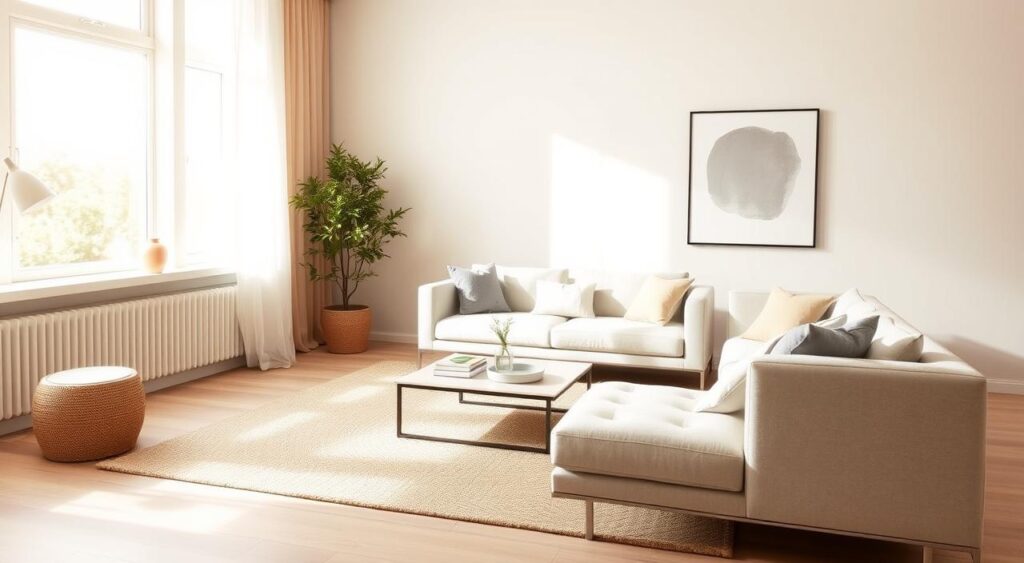Choosing the right wall color is key for modern home decor. It can greatly affect your space’s feel. With many options, picking the right one can be tough. You want your space to be stylish and functional.
This guide will help you find the perfect color for your taste. We’ll cover the psychology of colors, room function, and natural lighting. You’ll learn how to make a choice that fits your modern home decor and contemporary design.

Introduction to Wall Color Selection
The right wall color can make your space welcoming and show your style. Whether you’re into modern decor or contemporary design, the right color matters.
Key Takeaways
- Choose a wall color that reflects your personal taste and style for modern home decor ideas.
- Consider the room’s function and natural lighting when selecting a wall color for contemporary home design tips.
- Think about how different colors can affect your mood and the ambiance of your space.
- Don’t be afraid to experiment and try out different colors for your modern home decor ideas.
- Consider the color temperature and undertones of the wall color for contemporary home design tips.
- Test the color with a sample swatch before committing to a specific shade for modern home decor ideas.
Understanding the Psychology of Wall Colors
Choosing a wall color can affect how you feel and the mood of your space. Different colors can make you feel different emotions. For example, warm colors like red and orange can make you feel energetic. On the other hand, cool colors like blue and green can help you relax.
Using stylish interior decorating trends and minimalist home decor inspiration can make your space look good and work well. Think about these things when picking a wall color:
- Color temperature: Warm colors can make a space feel cozy. Cool colors can make it feel calm.
- Color intensity: Bright colors can energize you. Muted colors can calm you down.
- Cultural associations: Colors can mean different things in different cultures. It’s important to think about these meanings when choosing a color.
By understanding how colors affect us and using stylish interior decorating trends and minimalist home decor inspiration, you can make a space that shows your personality. Remember to think about the lighting and furniture in your space. This will help your chosen color fit well with everything else.
How Colors Affect Your Mood
Colors can really change how you feel. For example, blue is often seen as calming. Yellow is often seen as happy.
The Impact of Color on Room Perception
The color of your walls can change how you see your room. For example, light colors can make a room seem bigger. Dark colors can make it seem smaller.
Cultural Significance of Different Colors
Different colors mean different things in different cultures. For example, in many Asian cultures, red is lucky. In many Western cultures, it’s about love.
| Color | Cultural Association |
|---|---|
| Red | Good luck and prosperity (Asian cultures), love and passion (Western cultures) |
| Blue | Calmness and serenity (many cultures) |
| Yellow | Happiness and optimism (many cultures) |
Assessing Your Space Before Choosing a Wall Color
Choosing the right wall color is key. You need to think about the space’s natural light, furniture, and decor. Look at the room’s layout, window size, and lighting. This helps pick a color that fits well and makes the space feel right.
Think about adding chic home renovation ideas and trendy home accessories for elegance and style.
Start by making a list of important factors:
- Room orientation and natural lighting
- Window size and type
- Lighting fixtures and their impact on the space
- Furniture and decor style
- Personal preferences and lifestyle
These factors help narrow down your color choices. Pick a shade that makes your space look better. Think about how chic home renovation ideas and trendy home accessories

Consider the mood you want in your space. Do you want it calm or lively? Your wall color can change the room’s feel. Choose a color that matches your mood and style.
How to Choose a Wall Color That Matches Your Style
Choosing a wall color is all about finding a shade that fits your style and makes your space look great. Think about elegant room styling suggestions that match your furniture and decor. Consider the style of your home and the mood you want to create. Do you like a modern, sleek look or a cozy, traditional feel?
If you love modern home decor ideas, a bold and bright color can make your space pop. For a traditional vibe, try earthy tones that bring warmth and comfort. You might also like minimalist color approaches for a clean, calm look.
To find the right color, list your favorites and see how they match your furniture and decor. Look for inspiration online or in home decor magazines. Some great color combos include:
- Monochromatic schemes with different shades of the same color
- Complementary colors for a bold contrast
- Analogous colors that blend smoothly
By exploring these options, you can pick a wall color that shows off your style and makes your home look amazing.
The Role of Natural and Artificial Lighting
Choosing a wall color involves thinking about natural and artificial lighting. Natural light changes how your walls look throughout the day and seasons. To make your space both useful and beautiful, consider contemporary home design tips and lighting.
Using stylish interior decorating trends can enhance your lighting. Sheer curtains or blinds can soften natural light and cut glare. You can also add dimmable artificial lights to change your room’s mood. Here are some tips:
- Check your space’s natural light and pick a wall color that matches it.
- Think about your artificial lighting’s color temperature and how it will affect your walls.
- Choose energy-efficient lights that light up your space well.
By considering natural and artificial lighting, you can make a space that looks great and works well. Use contemporary home design tips and stylish interior decorating trends in your choices. Try out different lighting setups to find the best fit for your space.

Choosing the right wall color means looking at all factors, like lighting. This way, you can make a space that looks good and works well. It should also show off your personal style and preferences.
| Lighting Type | Color Temperature | Effect on Wall Color |
|---|---|---|
| Natural Light | Warm | Can make walls appear brighter and more vibrant |
| Incandescent Lighting | Warm | Can create a cozy and intimate atmosphere |
| Fluorescent Lighting | Cool | Can make walls appear cooler and more neutral |
Considering Room Function in Color Selection
Choosing a wall color depends on the room’s function. Each space has its own needs. Warm colors are great for living areas, while bedrooms need calming hues. Think about minimalist home decor inspiration to match your space.
Colors should match the room’s purpose. For example, a relaxing room needs soft colors. An entertainment room might do well with bright colors. Chic home renovation ideas can help you create a stylish, functional space.

- Living spaces: warm and inviting colors, such as beige or gray, can create a cozy atmosphere.
- Bedrooms: calming and soothing colors, such as blue or green, can promote relaxation.
- Kitchen and dining areas: bright and cheerful colors, such as yellow or orange, can stimulate appetite and conversation.
Choosing colors that fit each room’s function makes your space harmonious and functional. It should reflect your style and meet your needs. Mix minimalist home decor inspiration with chic home renovation ideas for a unique, welcoming atmosphere.
| Room Function | Recommended Colors |
|---|---|
| Living Spaces | Beige, Gray, Warm Neutrals |
| Bedrooms | Blue, Green, Calming Neutrals |
| Kitchen and Dining Areas | Yellow, Orange, Bright and Cheerful |
Working with Existing Furniture and Decor
When picking a wall color, think about your furniture and decor. Look at the colors, textures, and styles of your pieces. Choose a wall color that goes well with them. Adding trendy home accessories and elegant room styling suggestions can make your space look sophisticated and elegant.
Start by examining the colors and textures in your room. Make a list of the main colors and textures. This will help you pick a wall color that fits well. You can also use online tools or talk to a professional for more ideas.
- Choose a wall color that complements the dominant colors in your space
- Consider the texture and style of your furniture and accessories when selecting a wall color
- Don’t be afraid to add a pop of color with trendy home accessories or elegant room styling suggestions
By thinking about your furniture and decor, you can pick a wall color that makes your space look better. It will create a cohesive and stylish look.
Testing Colors Before Commitment
Choosing the right wall color is key to your space’s look. It’s smart to test colors before deciding. This way, you avoid wasting time and effort. Look into modern decor and design tips to make your space stylish and useful.
Start by painting a small wall section with your chosen color. See how it looks in various lights. You can also use digital tools to see the color on your walls. These tools include online color pickers and mobile apps.
Sample Testing Methods
- Paint a small section of the wall with the desired color
- Use a paint sample or a swatch to test the color
- Observe the color in different lighting conditions
Digital Color Visualization Tools
Digital tools are great for testing colors. They let you upload a photo of your space and try different colors. This helps you see how the color will look in your space.
Testing colors ensures you pick one that fits your space and style. Whether you’re into modern decor or contemporary design, testing is a must.
| Color | Lighting Condition | Result |
|---|---|---|
| Light Blue | Natural Light | Calm and Soothing |
| Dark Gray | Artificial Light | Dramatic and Moody |
Understanding Color Temperature and Undertones
Choosing the right wall color is all about color temperature and undertones. Warm colors like orange and red make a space cozy. Cool colors like blue and green bring calm. To pick the perfect color, think about stylish interior decorating trends and minimalist home decor inspiration.
Warm colors make a room feel close and cozy. Cool colors make it feel open and calm. Knowing a color’s undertones helps it match your furniture and decor. For instance, a yellow undertone brightens a room, while a blue undertone soothes it.
To use stylish interior decorating trends and minimalist home decor inspiration well, follow these tips:
- Warm undertones are great for cozy living rooms or bedrooms.
- Cool undertones are best for calming bathrooms or kitchens.
- Think about your space’s natural light and how it changes color temperature and undertones.
Understanding color temperature and undertones helps you create a beautiful and functional space. Always keep stylish interior decorating trends and minimalist home decor inspiration in mind. This way, your space will show off your style and meet your needs.
| Color Temperature | Undertones | Effect |
|---|---|---|
| Warm | Yellow, orange | Cozy, intimate |
| Cool | Blue, green | Calming, soothing |
Coordinating Colors Between Rooms
Creating a sense of flow and harmony in your home starts with coordinating colors. You can tie rooms together with a color scheme or use transitional colors. A neutral color palette is a chic way to keep things consistent.
Using a color wheel helps pick complementary colors. These colors are opposite each other and balance your home. Add trendy accessories like throw pillows to bring each room together.
Creating Flow Throughout Your Home
To make your home flow well, follow these tips:
- Use a consistent color scheme throughout your home
- Select colors that complement each other
- Add trendy home accessories to each room to create a sense of cohesion
These tips help your home feel welcoming. Think about chic renovation ideas and trendy accessories when choosing colors and decor.
Transitional Color Techniques
Transitional colors help connect different colors in your home. Choose a transition color that’s close to both, for continuity. Trendy accessories like rugs and lights can also add color and unity.
| Color | Complementary Color | Transition Color |
|---|---|---|
| Blue | Orange | Green |
| Red | Green | Yellow |
By using transitional colors and chic accessories, your home will feel more connected and inviting.
Common Color Selection Mistakes to Avoid
Choosing the right wall color can be tricky. To make your space look elegant, avoid common mistakes. One big error is not thinking about the room’s natural light. This can make a color look great in the store but not in your home.
Another mistake is not considering the room’s purpose. Colors should match the room’s function. For example, a bedroom needs calming colors, while a home office needs something stimulating. By choosing colors that fit the room’s purpose, you can make it stylish and useful.
Some common mistakes to avoid include:
- Not testing the color before committing to it
- Ignoring the natural lighting in the room
- Not considering the room’s function
- Not thinking about the color temperature and undertones
Knowing these mistakes helps you choose the right wall color. Think about elegant room styling suggestions and modern home decor ideas to make your space beautiful and functional.
With careful planning, you can create a space that shows your style and meets your needs. Avoiding common mistakes and using modern home decor ideas will help you achieve an elegant and useful space.
Conclusion: Making Your Final Color Decision
When choosing your wall color, think about what you like and how it will work in your space. The right color should match your style and make your home feel good. It’s all about finding a color that looks great and works well.
Wall color is a key part of stylish interior decorating. With some research and trying out different colors, you can make any room look amazing. Trust your gut, check out new trends, and be open to trying new things. The perfect wall color is out there, waiting for you to find it.
FAQ
How do colors affect my mood and the perception of a room?
Colors greatly influence the mood and feel of a room. Warm colors like red and orange can make a space feel energetic. Cool colors, such as blue and green, can make it calm and serene.
What factors should I consider when assessing my space before choosing a wall color?
Assessing your space is key before picking a wall color. Look at the natural light, furniture, and decor. Consider the room’s layout, window size, and lighting. This helps pick a color that fits well with your space.
How do I choose a wall color that matches my personal style?
Picking a wall color that fits your style can be tough. Look at modern, traditional, and minimalist color trends. Match the color to your furniture, decor, and accessories for a cohesive look.
How do natural and artificial lighting affect the appearance of my wall color?
Lighting greatly changes how your wall color looks. Think about the lighting in your space, day and season. This helps pick a color that looks good under different lights.
How does the function of a room influence the best wall color choice?
The room’s purpose affects the best wall color. Living areas might need warm colors, while bedrooms should have calming ones. Choose colors that match the room’s function.
How do I incorporate my existing furniture and decor when choosing a wall color?
Consider your furniture and decor when picking a wall color. Match the color to your furniture, rugs, and accessories. This creates a harmonious look.
What methods can I use to test colors before committing to a specific shade?
Testing colors before choosing is wise. You can paint a small area or use digital tools. This saves time and effort.
How do color temperature and undertones impact the appearance of my wall color?
Color temperature and undertones change how your wall color looks. Warm colors are energetic, while cool ones are calming. Knowing this helps pick the right mood for your space.
How can I coordinate colors between rooms to create a cohesive flow throughout my home?
To link rooms with color, create a shared color scheme. Or use transitional colors to connect different hues. This creates a smooth flow in your home.
What are some common color selection mistakes I should avoid?
Choosing the right wall color can be tricky. Avoid mistakes like ignoring natural light or not testing colors. These errors can lead to the wrong choice.

